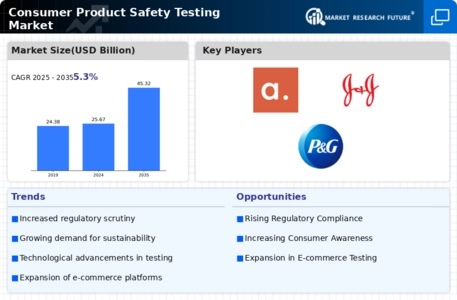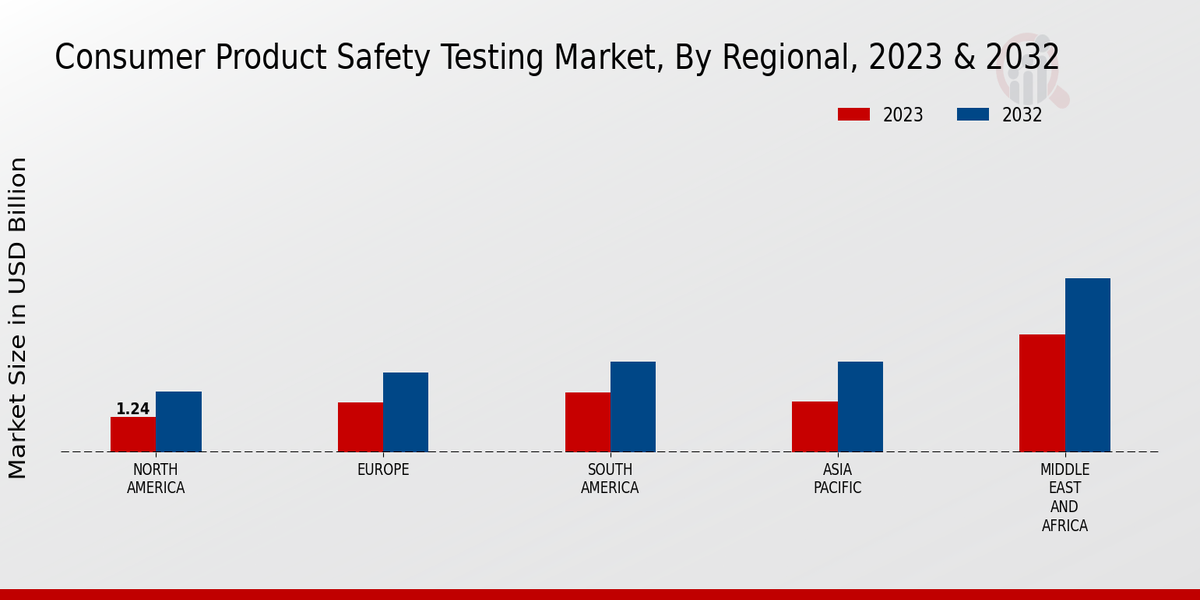Market Growth Projections
The Global Consumer Product Safety Testing Market Industry is projected to experience substantial growth in the coming years. With a market value expected to reach 25.67 USD Billion in 2024 and further expand to 45.32 USD Billion by 2035, the industry is poised for a robust trajectory. This growth is indicative of the increasing emphasis on product safety across various sectors, including electronics, toys, and food products. The anticipated CAGR of 5.3% from 2025 to 2035 underscores the ongoing investment in safety testing as companies strive to meet evolving consumer expectations and regulatory demands.
Growing Consumer Awareness
Consumer awareness regarding product safety is on the rise, significantly impacting the Global Consumer Product Safety Testing Market Industry. As consumers become more informed about potential risks associated with various products, they increasingly demand transparency and assurance of safety from manufacturers. This heightened awareness has prompted companies to prioritize safety testing to maintain consumer trust and brand reputation. The market is projected to expand to 45.32 USD Billion by 2035, reflecting the growing emphasis on safety in consumer choices. Consequently, businesses are likely to enhance their testing protocols to meet consumer expectations and regulatory standards.
Increasing Regulatory Compliance
The Global Consumer Product Safety Testing Market Industry is witnessing a surge in demand driven by stringent regulatory compliance requirements. Governments worldwide are implementing more rigorous safety standards to protect consumers from hazardous products. For instance, the U.S. Consumer Product Safety Commission has established comprehensive guidelines that manufacturers must adhere to, which has led to an increased need for testing services. This trend is expected to contribute to the market's growth, with projections indicating a market value of 25.67 USD Billion in 2024. As compliance becomes more complex, companies are likely to invest in safety testing to avoid penalties and ensure product reliability.
Expansion of E-commerce Platforms
The rapid expansion of e-commerce platforms is significantly influencing the Global Consumer Product Safety Testing Market Industry. As online shopping continues to grow, consumers are exposed to a wider array of products, increasing the potential for unsafe items to enter the market. This has led to heightened scrutiny from regulatory bodies and a corresponding demand for rigorous safety testing of products sold online. Companies are now more inclined to invest in comprehensive testing to ensure compliance and protect their brand image. The market's growth trajectory suggests a value of 25.67 USD Billion in 2024, driven by the need for enhanced safety measures in the e-commerce sector.
Rising Demand for Sustainable Products
The Global Consumer Product Safety Testing Market Industry is also being propelled by the rising demand for sustainable products. As consumers increasingly prioritize eco-friendly and sustainable options, manufacturers are compelled to ensure that their products meet safety standards while also being environmentally responsible. This dual focus on safety and sustainability has led to the development of new testing protocols that assess both aspects. The market is anticipated to grow at a CAGR of 5.3% from 2025 to 2035, reflecting the increasing integration of sustainability in product development. Companies that align their testing practices with these consumer preferences may enhance their market position.
Technological Advancements in Testing Methods
Technological advancements are reshaping the Global Consumer Product Safety Testing Market Industry, enabling more efficient and accurate testing methods. Innovations such as automated testing equipment and advanced analytical techniques allow for quicker turnaround times and improved detection of hazardous substances. For example, the integration of artificial intelligence in testing processes can enhance the precision of results, thereby increasing consumer confidence in product safety. As these technologies evolve, they are expected to drive market growth, contributing to a projected CAGR of 5.3% from 2025 to 2035. Companies that adopt these advancements may gain a competitive edge in the marketplace.













